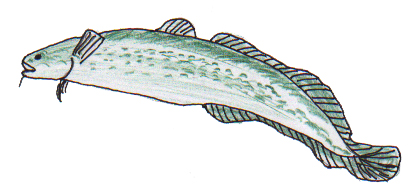 Marshall
Cultural Atlas Marshall
Cultural Atlas
This collection of student work is from
Frank Keim's classes. He has wanted to share these works for others
to use as an example of Culturally-based curriculum and documentation. These
documents have been OCR-scanned. These are available
for educational use only.
Burbot
(Lota Iota)
(Manignaq)
The burbot is one of the most unattractive
freshwater fishes native to Alaska. Its external features have been
responsible for much prejudice against it. But it is a popular
recreational fish. They bite readily on baits of all kind, and are
very popular to winter ice-fishing enthusiasts. They are relatives of
the codfish family and prefer to live in deep lake water. They are
known by a variety of names like ling, freshwater lush and eel pout.
The scientific name, Lota Iota, came from the old French "Lotte"
which is equivalent in English to "pout."
On the underside of the chin near the tip there is
a single prominent barbel, or "chin whisker." It also has two dorsal
fins occurring along its back. The dorsal fins and anal fins run from
the middle of the body almost to the tail which is rounded rather
than square or forked. They are characterized by their eel-like body
shape and olive-black skin coloration interspersed with yellow
mottles and they appear to be scaleless although they actually have a
small microscopic scale.
Burbot are found throughout Interior Alaska and
are common in Canada, the Great Lakes Basin, and the Northern Rocky
Mountain States. In Siberia and Northern Europe the same species
exists. They generally prefer cool, deep lake waters and have been
reported at depths of 700 feet. Here in Alaska they are found in
streams and in lakes of all sizes, such as Lake Louise, Lake Tyone
and Lake Susitna.
In Alaska, Burbot become sexually mature when they
reach a length of 12-18 inches. At this time they are four to seven
years old. Spawning occurs from February-April. As the adult fish
move through shallow water, eggs and milt are discharged. The
fertilized eggs then sink to the bottom where they remain until they
hatch. Burbot grow slowly and live for more than 16 years.
Lois Moore

Christmastime Tales
Stories real and imaginary about Christmas, Slavik, and the New Year
Winter, 1996 |
Christmastime Tales II
Stories about Christmas, Slavik, and the New Year
Winter, 1998 |
Christmastime Tales III
Stories about Christmas, Slavik, and the New Year
Winter, 2000 |
| Summer Time Tails 1992 |
Summertime Tails II 1993 |
Summertime Tails III |
| Summertime Tails IV Fall, 1995 |
Summertime Tails V Fall, 1996 |
Summertime Tails VI Fall, 1997 |
| Summertime Tails VII Fall, 1999 |
Signs of the Times November 1996 |
Creative Stories From Creative Imaginations |
| Mustang Mind Manglers - Stories of the Far Out,
the Frightening and the Fantastic 1993 |
Yupik Gourmet - A Book of
Recipes |
|
| M&M Monthly |
|
|
| Happy Moose Hunting! September Edition 1997 |
Happy Easter! March/April 1998 |
Merry Christmas December Edition 1997 |
| Happy Valentine’s
Day! February Edition
1998 |
Happy Easter! March/April Edition 2000 |
Happy Thanksgiving Nov. Edition, 1997 |
| Happy Halloween October 1997 Edition |
Edible and Useful Plants of Scammon
Bay |
Edible Plants of Hooper Bay 1981 |
| The Flowers of Scammon Bay Alaska |
Poems of Hooper Bay |
Scammon Bay (Upward Bound Students) |
| Family Trees and the Buzzy Lord |
It takes a Village - A guide for parents May 1997 |
People in Our Community |
| Buildings and Personalities of
Marshall |
Marshall Village PROFILE |
Qigeckalleq Pellullermeng ‘A
Glimpse of the Past’ |
| Raven’s
Stories Spring 1995 |
Bird Stories from Scammon Bay |
The Sea Around Us |
| Ellamyua - The Great Weather - Stories about the
Weather Spring 1996 |
Moose Fire - Stories and Poems about Moose November,
1998 |
Bears Bees and Bald Eagles Winter 1992-1993 |
| Fish Fire and Water - Stories about fish, global warming
and the future November, 1997 |
Wolf Fire - Stories and Poems about Wolves |
Bear Fire - Stories and Poems about Bears Spring,
1992 |
|